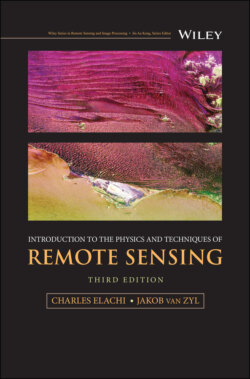Читать книгу Introduction to the Physics and Techniques of Remote Sensing - Jakob J. van Zyl - Страница 2
Table of Contents
Оглавление1 Cover
2 Series Page
3 Title Page
4 Copyright Page
5 Dedication Page
6 Preface
7 1 Introduction 1.1 Types and Classes of Remote Sensing Data 1.2 Brief History of Remote Sensing 1.3 Remote Sensing Space Platforms 1.4 Transmission Through the Earth and Planetary Atmospheres References and Further Reading
8 2 Nature and Properties of Electromagnetic Waves 2.1 Fundamental Properties of Electromagnetic Waves 2.2 Nomenclature and Definition of Radiation Quantities 2.3 Generation of Electromagnetic Radiation 2.4 Detection of Electromagnetic Radiation 2.5 Interaction of Electromagnetic Waves with Matter: Quick Overview 2.6 Interaction Mechanisms Throughout the Electromagnetic Spectrum Exercises References and Further Reading
9 3 Solid Surfaces Sensing in the Visible and Near Infrared 3.1 Source Spectral Characteristics 3.2 Wave–Surface Interaction Mechanisms 3.3 Signature of Solid Surface Materials 3.4 Passive Imaging Sensors 3.5 Types of Imaging Systems 3.6 Description of Some Visible/Infrared Imaging Sensors 3.7 Active Sensors 3.8 Surface Sensing at Very Short Wavelengths 3.9 Image Data Analysis Exercises References and Further Reading
10 4 Solid‐Surface Sensing: Thermal Infrared 4.1 Thermal Radiation Laws 4.2 Heat Conduction Theory 4.3 Effect of Periodic Heating 4.4 Use of Thermal Emission in Surface Remote Sensing 4.5 Use of Thermal Infrared Spectral Signature in Sensing 4.6 Thermal Infrared Sensors Exercises References and Further Reading
11 5 Solid‐Surface Sensing: Microwave Emission 5.1 Power‐Temperature Correspondence 5.2 Simple Microwave Radiometry Models 5.3 Applications and Use in Surface Sensing 5.4 Description of Microwave Radiometers 5.5 Examples of Developed Radiometers Refevrences and Further Reading
12 6 Solid‐Surface Sensing 6.1 Surface Interaction Mechanism 6.2 Basic Principles of Radar Sensors 6.3 Imaging Sensors: Real Aperture Radars 6.4 Imaging Sensors: Synthetic Aperture Radars 6.5 Nonimaging Radar Sensors: Scatterometers 6.6 Nonimaging Radar Sensors: Altimeters 6.7 Nonconventional Radar Sensors 6.8 Subsurface Sounding References and Further Reading
13 7 Ocean Surface Sensing 7.1 Physical Properties of the Ocean Surface 7.2 Mapping of the Ocean Topography 7.3 Surface Wind Mapping 7.4 Ocean Surface Imaging Exercises References and Further Reading
14 8 Basic Principles of Atmospheric Sensing and Radiative Transfer 8.1 Physical Properties of the Atmosphere 8.2 Atmospheric Composition 8.3 Particulates and Clouds 8.4 Wave Interaction Mechanisms in Planetary Atmospheres 8.5 Optical Thickness 8.6 Radiative Transfer Equation 8.7 Case of a Nonscattering Plane Parallel Atmosphere 8.8 Basic Concepts of Atmospheric Remote Sounding Exercises References and Further Reading
15 9 Atmospheric Remote Sensing in the Microwave Region 9.1 Microwave Interactions with Atmospheric Gases 9.2 Basic Concept of Downlooking Sensors 9.3 Basic Concept for Uplooking Sensors 9.4 Basic Concept for Limblooking Sensors 9.5 Inversion Concepts 9.6 Basic Elements of Passive Microwave Sensors 9.7 Surface Pressure Sensing 9.8 Atmospheric Sounding by Occultation 9.9 Microwave Scattering by Atmospheric Particles 9.10 Radar Sounding of Rain 9.11 Radar Equation for Precipitation Measurement 9.12 The Tropical Rainfall Measuring Mission (TRMM) 9.13 Rain Cube 9.14 CloudSat 9.15 Cassini Microwave Radiometer 9.16 Juno Microwave Radiometer (MWR) References and Further Reading
16 10 Millimeter and Submillimeter Sensing of Atmospheres 10.1 Interaction with Atmospheric Constituents 10.2 Downlooking Sounding 10.3 Limb Sounding 10.4 Elements of a Millimeter Sounder 10.5 Submillimeter Atmospheric Sounder Exercises References and Further Reading
17 11 Atmospheric Remote Sensing in the Visible and Infrared 11.1 Interaction of Visible and Infrared Radiation with the Atmosphere 11.2 Downlooking Sounding 11.3 Limb Sounding 11.4 Sounding of Atmospheric Motion 11.5 Laser Measurement of Wind 11.6 Atmospheric Sensing at Very Short Wavelengths Exercises References and Further Reading
18 12 Ionospheric Sensing 12.1 Properties of Planetary Ionospheres 12.2 Wave Propagation in Ionized Media 12.3 Ionospheric Profile Sensing by Topside Sounding 12.4 Ionospheric Profile by Radio Occultation References and Further Reading
19 Appendix A: Use of Multiple Sensors for Surface Observations
20 Appendix B: Summary of Orbital Mechanics Relevant to Remote Sensing B.1 Circular Orbits B.2 Elliptical Orbits B.3 Orbit Selection Exercises
21 Appendix C: Simplified Weighting Functions C.1 Case of Downlooking Sensors (Exponential Atmosphere) C.2 Case of Downlooking Sensors (Linear Atmosphere) C.3 Case of Upward‐Looking Sensors
22 Appendix D: Compression of a Linear FM Chirp Signal
23 Index
24 End User License Agreement
